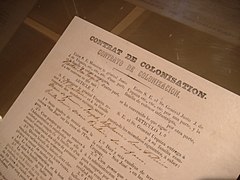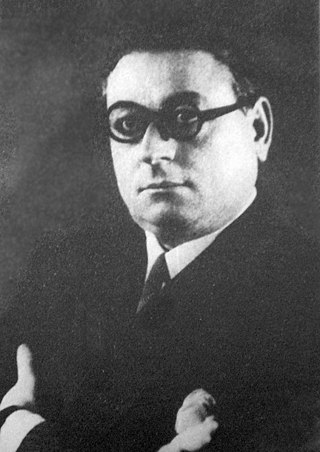
Alberto Gerchunoff, was an Argentine writer born in the Russian Empire, in the city of Proskuriv, now Khmelnytskyi, Ukraine.
This is a partial timeline of Zionism since the start of the 16th century.
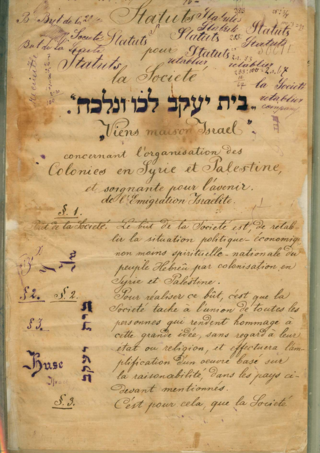
Bilu was a Jewish movement of the late 19th century, fueled predominantly by the immigration of Russian Jews, whose goal was the agricultural settlement of the Land of Israel. Its members were known as Bilu'im, and the movement sought to inspire Jews to migrate to Ottoman Palestine. The Bilu'im rejected progressive notions such as Emancipation and assimilation as viable options for Jewish survival. The movement collapsed as a result of the challenging farming conditions in Palestine and a lack of funding to sustain the settlers.

Leon Pinsker or Judah Leib Pinsker was a physician and Zionist activist.

The Uganda Scheme was a proposal by British Colonial Secretary Joseph Chamberlain to create a Jewish homeland in a portion of British East Africa. It was presented at the Sixth World Zionist Congress in Basel in 1903 by Theodor Herzl, the founder of the modern Zionist movement. He presented it as a temporary refuge for Jews to escape rising antisemitism in Europe. The proposal faced opposition from both the Zionist movement and the British Colony.

Der Judenstaat is a pamphlet written by Theodor Herzl and published in February 1896 in Leipzig and Vienna by M. Breitenstein's Verlags-Buchhandlung. It is subtitled with "Versuch einer modernen Lösung der Judenfrage" and was originally called "Address to the Rothschilds", referring to the Rothschild family banking dynasty, as Herzl planned to deliver it as a speech to the Rothschild family. Baron Edmond de Rothschild rejected Herzl's plan, feeling that it threatened Jews in the Diaspora. He also thought it would put his own settlements in Palestine at risk.

Moritz Freiherr von Hirsch auf Gereuth, commonly known as Maurice de Hirsch, was a German Jewish financier and philanthropist who set up charitable foundations to promote Jewish education and improve the lot of oppressed European Jewry. He was the founder of the Jewish Colonization Association, which sponsored large-scale Jewish immigration to Argentina.
Moisés Ville is a small town (comuna) in the province of Santa Fe, Argentina, founded on 23 October 1889 by Eastern European and Russian Jews escaping pogroms and persecution. The original name intended for the town was Kiryat Moshe honoring Baron Maurice Moshe Hirsch, but the land agent who registered the settlement translated it to the French-like Moïsesville which was later hispanized to the current Moisés Ville. The town is located about 177 km (110 mi) from the provincial capital, in the San Cristóbal Department and 616 km (383 mi) from Buenos Aires. It had 2,425 inhabitants at the 2010 census [INDEC].
Jewish gauchos were Jewish immigrants who settled in fertile regions of Argentina in agricultural colonies established by the Jewish Colonization Association. The association was established by Baron Maurice de Hirsch, a Jewish-French industrialist who amassed a fortune building railroads in Russia. After the death of his son, Hirsch resolved to help Russia's Jews and bought more than 80,000 hectares of land in Argentina. Among these colonies are Colonia Lapin and Rivera in the Province of Buenos Aires and Basavilbaso in Entre Ríos. Most of these immigrants were from Podolia and Bessarabia, in Imperial Russia.

The Jewish Colonisation Association, was an organisation created on September 11, 1891, by Baron Maurice de Hirsch. Its aim was to facilitate the mass emigration of Jews from Russia and other Eastern European countries, by settling them in agricultural settlements on lands purchased by the committee in North America, South America and Ottoman Palestine. Today ICA is still active in Israel in supporting specific development projects under the name Jewish Charitable Association (ICA).
The First Aliyah, also known as the agriculture Aliyah, was a major wave of Jewish immigration (aliyah) to Ottoman Palestine between 1881 and 1903. Jews who migrated in this wave came mostly from Eastern Europe and from Yemen, stimulated by pogroms and violence against the Jewish communities in those areas. An estimated 25,000 Jews immigrated. Many of the European Jewish immigrants during the late 19th-early 20th century period gave up after a few months and went back to their country of origin, often suffering from hunger and disease.
The Second Aliyah was an aliyah that took place between 1904 and 1914, during which approximately 35,000 Jews, mostly from Russia, with some from Yemen, immigrated into Ottoman Palestine.
The Andinia Plan is a conspiracy theory that alleged plans to establish a Jewish state in parts of Argentina and Chile. It is partly based on historical organized Jewish migration to Argentina and proposals for a Jewish state there in the late 19th and the early 20th century.

The Jewish Territorial Organisation, known as the ITO, was a Jewish political movement which first arose in 1903 in response to the British Uganda Scheme, but only institutionalized in 1905. Its main goal was to find an alternative territory to that of Palestine, which was preferred by the Zionist movement, for the creation of a Jewish homeland. The organization embraced what became known as Jewish Territorialism also known as Jewish Statism. The ITO was dissolved in 1925.

The history of the Jews in Argentina goes back to the early sixteenth century, following the expulsion of Jews from Spain. Sephardic Jews fleeing persecution immigrated with explorers and colonists to settle in what is now Argentina, in spite of being forbidden from travelling to the American colonies. In addition, many of the Portuguese traders in the Viceroyalty of the Río de la Plata were Jewish. An organized Jewish community, however, did not develop until after Argentina gained independence from Spain in 1816. By mid-century, Jews from France and other parts of Western Europe, fleeing the social and economic disruptions of revolutions, began to settle in Argentina. Argentines of both Ashkenazi and Sephardic heritage have left their mark on all aspects of Argentine culture, including in areas such as cuisine.
As an organized nationalist movement, Zionism is generally considered to have been founded by Theodor Herzl in 1897. However, the history of Zionism began earlier and is intertwined with Jewish history and Judaism. The organizations of Hovevei Zion, held as the forerunners of modern Zionist ideals, were responsible for the creation of 20 Jewish towns in Palestine between 1870 and 1897.
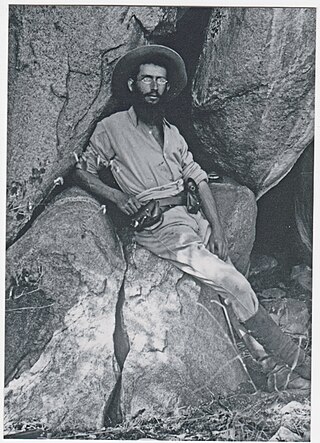
Leopold Kessler (1864–1944) was an engineer, newspaper publisher and Zionist. He was instrumental in building many of the institutions that supported the establishment of Israel as a Jewish state.

The Jewish Gauchos, is a novel of Ukrainian-born Argentine writer and journalist Alberto Gerchunoff, who is regarded as the founder of Jewish literature in Latin America. Gerchunoff published the work in 1910, during the celebrations of Argentina's May Revolution centennial. The Encyclopaedia Judaica states that The Jewish Gauchos is the first Latin American literary piece depicting Jewish immigration to the New World, and the first literary work written in Spanish by a Jewish author in modern times. The novel ranks 35th in the "Jewish Cannon", which lists the best 100 books of modern Jewish Literature.
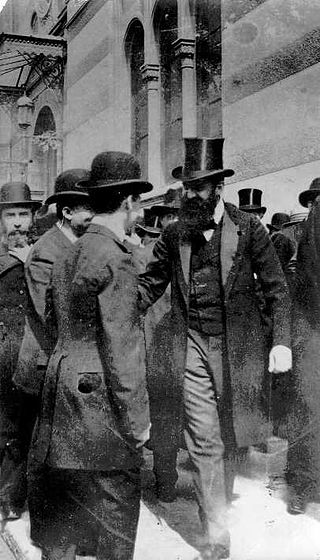
The Sixth Zionist Congress was held in Basel, opening on August 23, 1903. Theodor Herzl caused great division amongst the delegates when he presented the "Uganda Scheme", a proposed Jewish colony in what is now part of Kenya. Herzl died the following year.

Various agricultural settlements in Argentina housed Eastern European Jews fleeing persecution in hopes of establishing a new life in the wake of the Kiev Pogroms. German Jewish philanthropist Baron Maurice de Hirsch created the settlements to build a future for Eastern European Jewry around the world. After seeing an increase in antisemitism, Hirsch hoped to bring targeted Jews a more substantial solution than charity. As a result, Hirsch created the Jewish Colonisation Association to pursue this goal and used all his fortune to establish colonies in the Argentine Empire. Colonies included Mauricio, Moisesville, Villa Clara, San Antonio. Common struggles included finding funding and arable land, as well as leadership issues. Today, as a result, many of the colonies have lost their Jewish culture.
